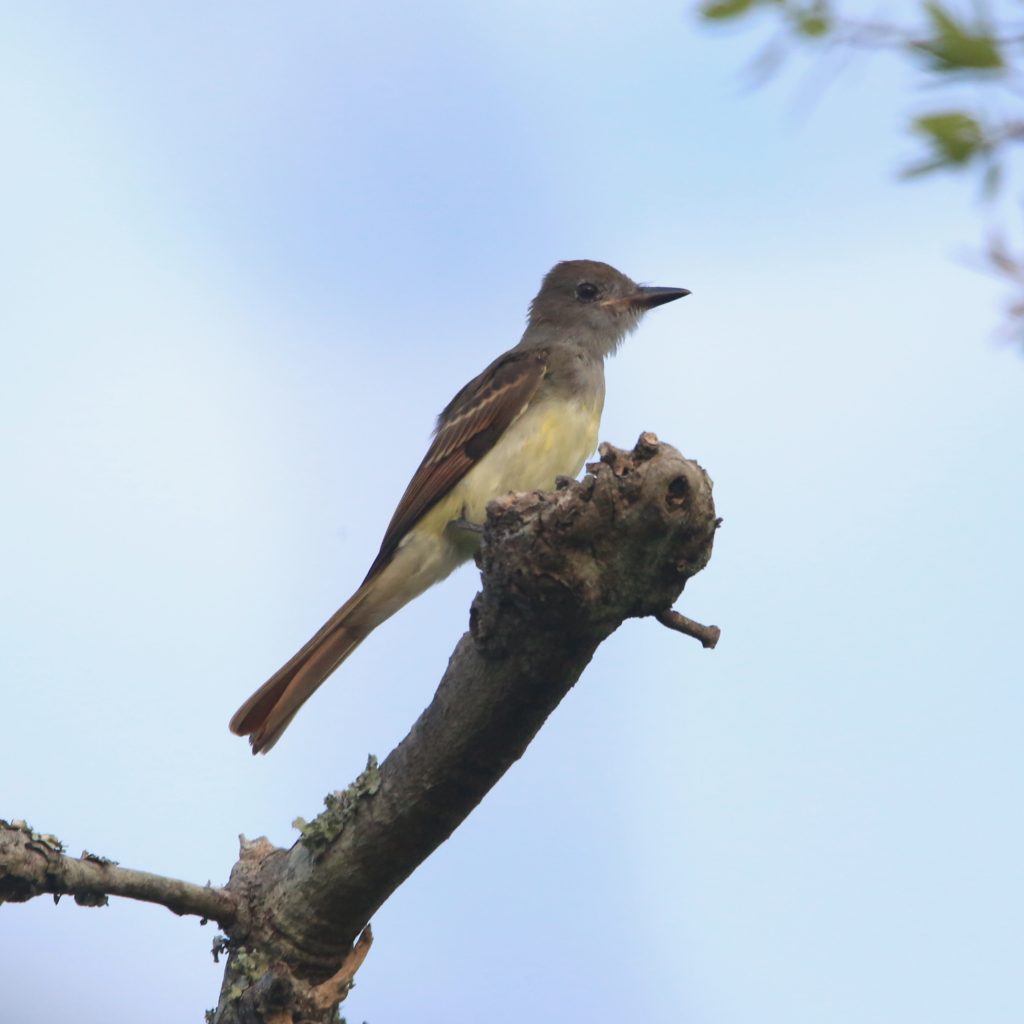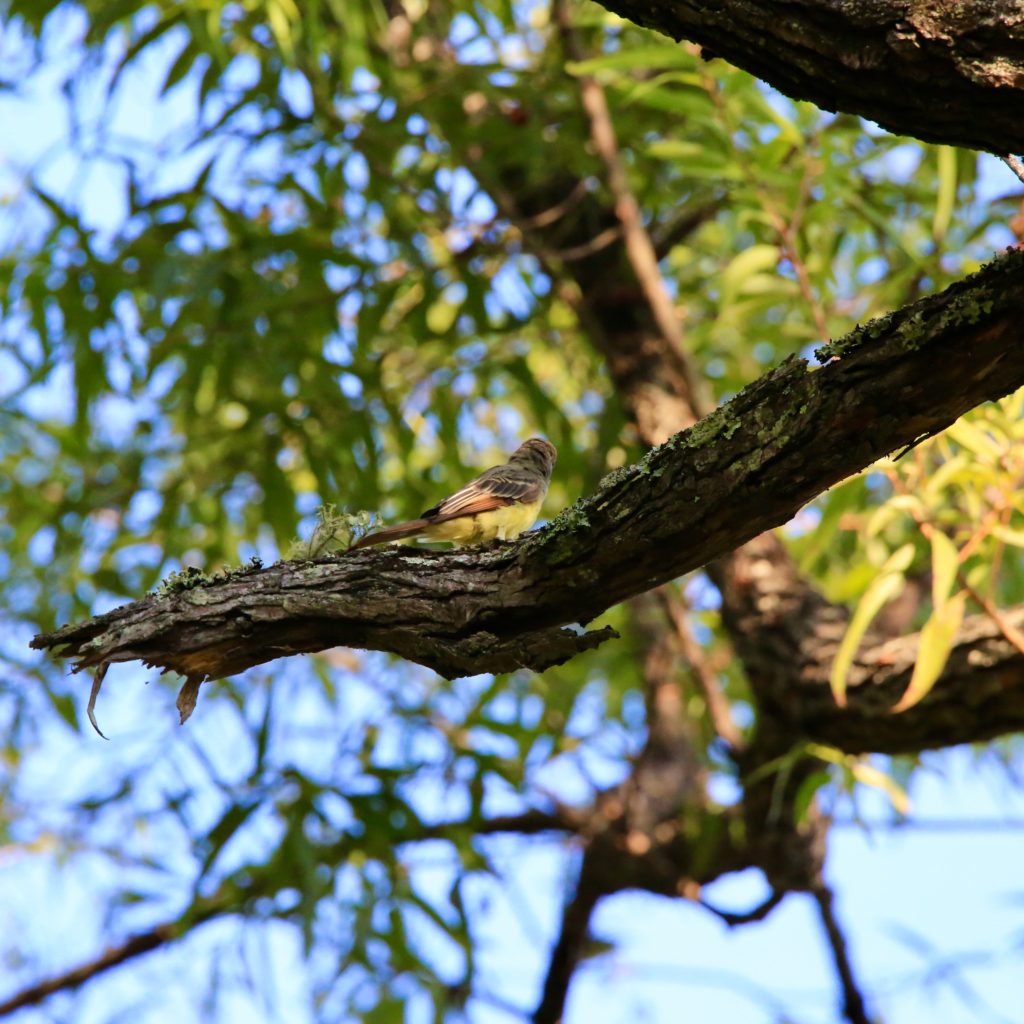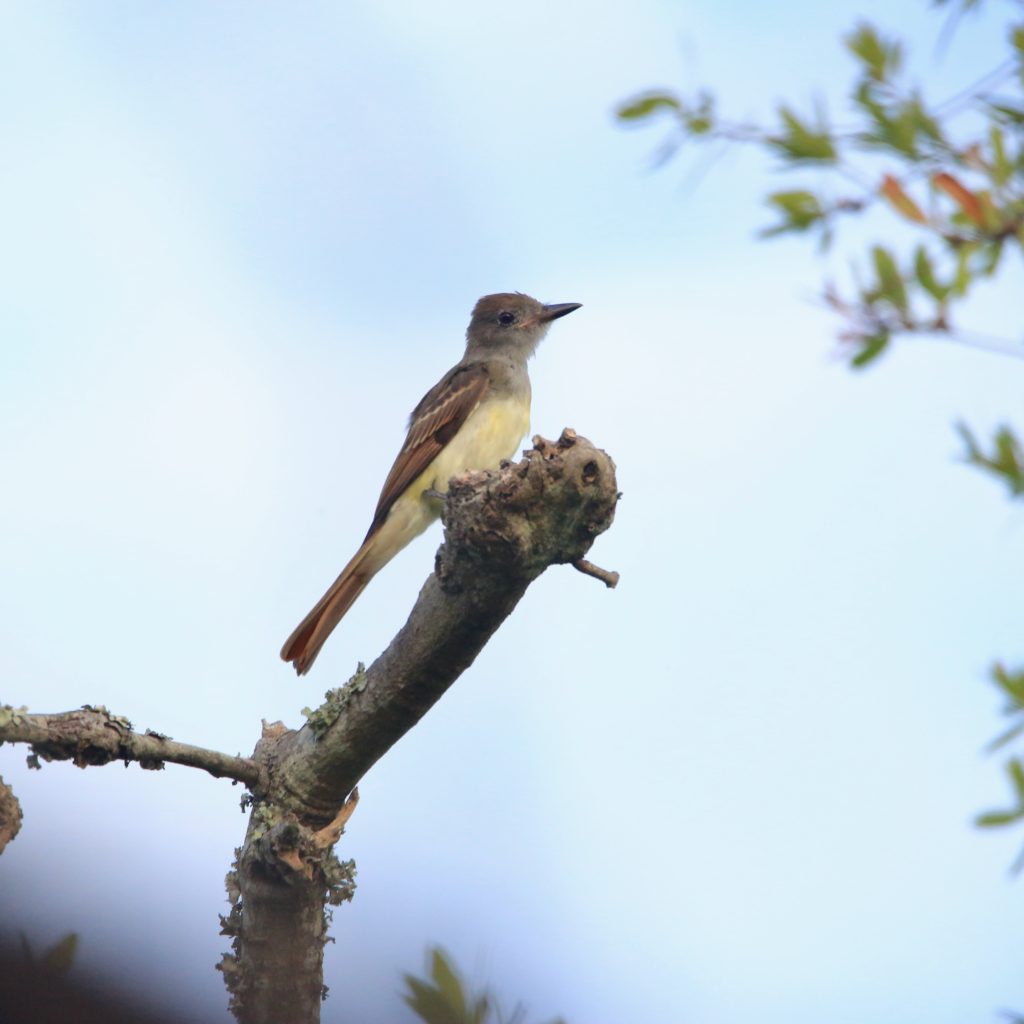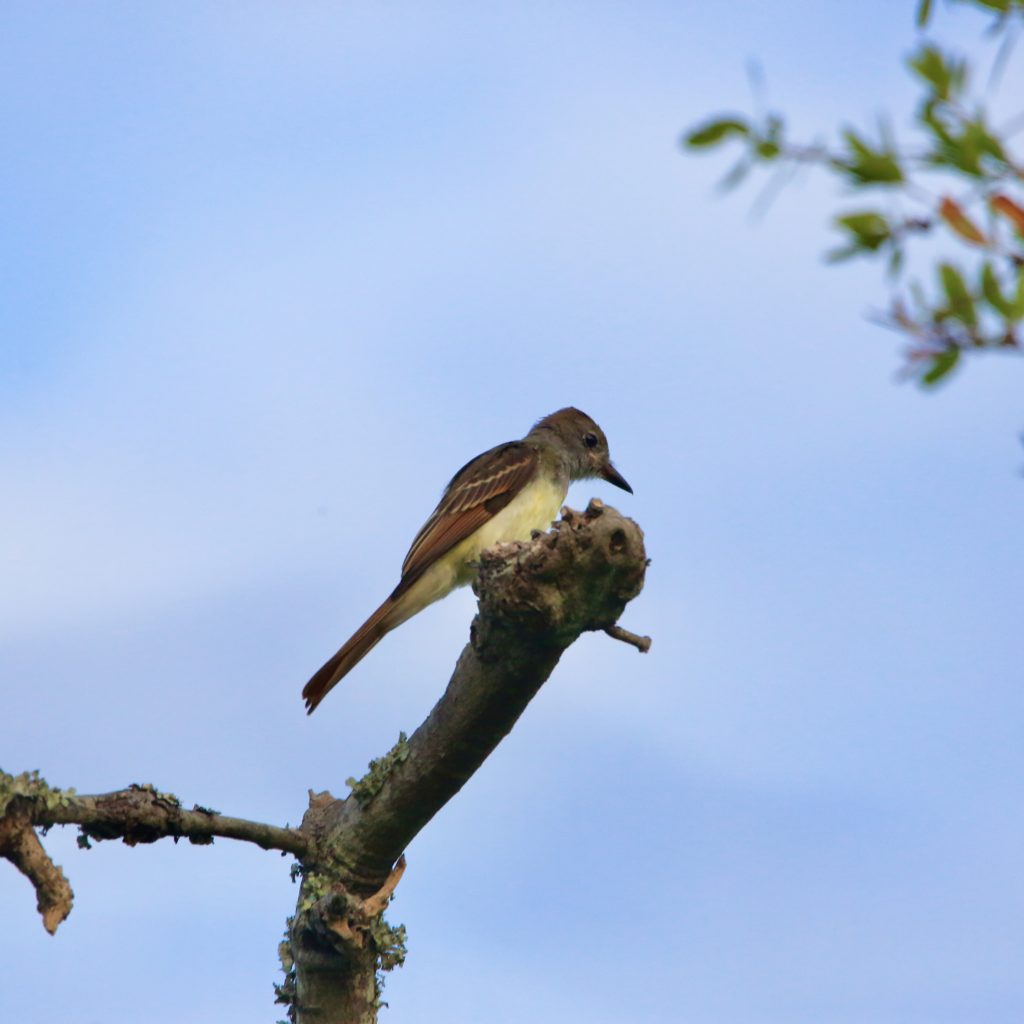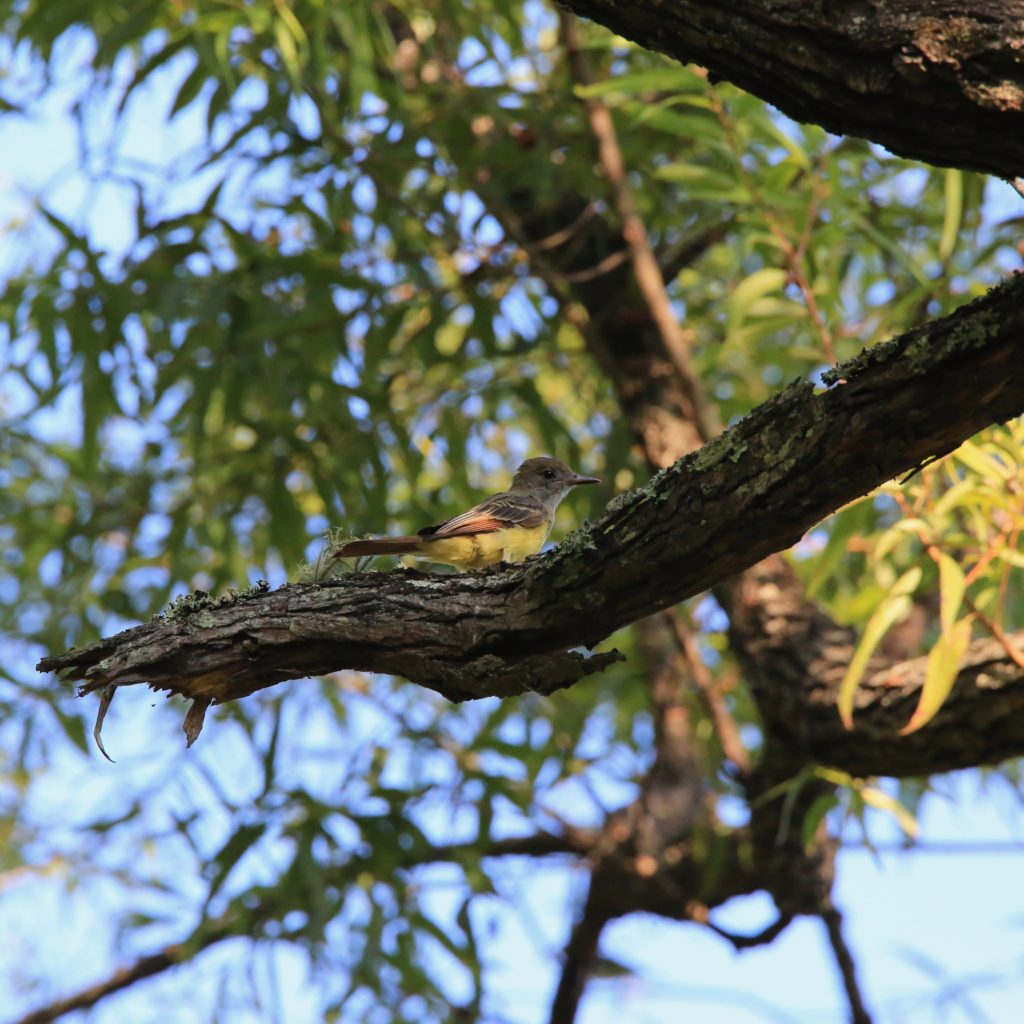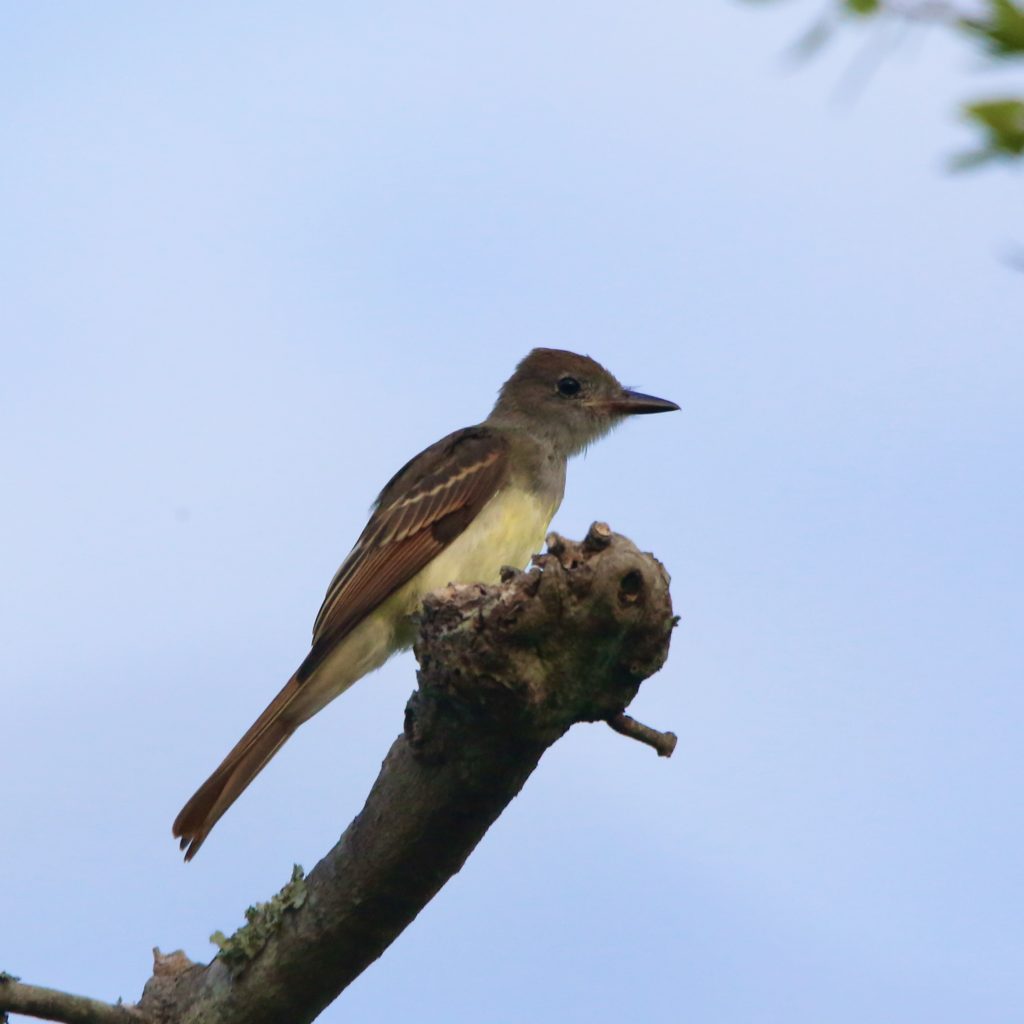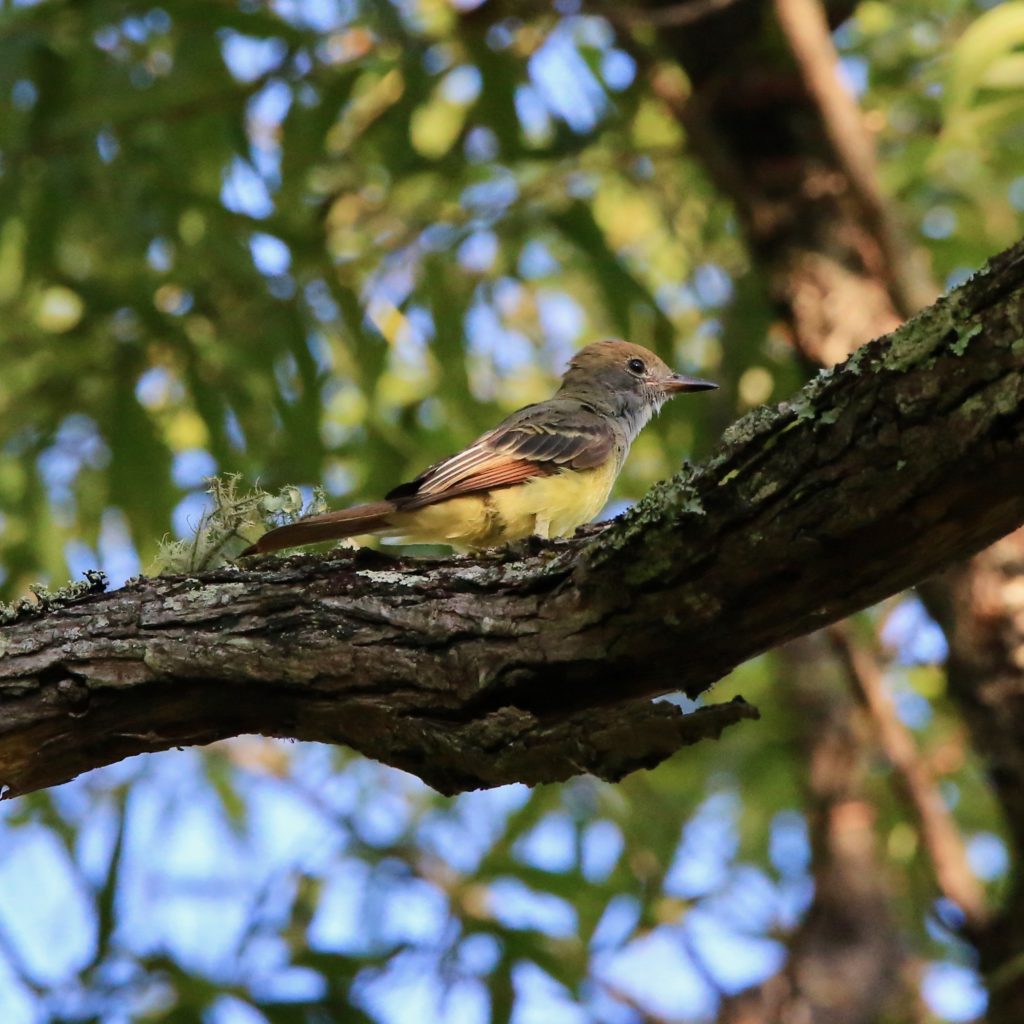
With distinctive and high-pitched whistles piercing through the Eastern woodlands of North America, the Great Crested Flycatcher is an elegant bird with distinct lemon-yellow bellies. They are secretive and can be rather elusive, but attentive birdwatchers may be rewarded with a flash of reddish-brown and yellow if they closely trace their harsh calls back to their sources.
About Great Crested Flycatchers
They belong to the largest genera of Flycatchers, and one can find their close relatives spread across the continent of North America. It is fortunately also one of the best-studied Flycatchers, paving the way for an abundance of information that can be used to understand these timid birds better. Like other birds in the family of Flycatchers, they chase after flying insects before catching them mid-air, thereby giving rise to their names. They are also some of the few birds that have benefitted from deforestation due to their preference for living along the edges of woodlands. This fragmentation of densely wooded habitats has worked to their advantage and has increased their populations over the years. Primarily spending most of their time on treetops, they are mainly to be heard and not seen.
● Great Crested Flycatchers Photos, Color Pattern, Song
● Great Crested Flycatchers Size, Eating Behavior, Habitat
● Great Crested Flycatchers Range and Migration, Nesting
GET KIDS BIRD WATCHING
Great Crested Flycatcher Color Pattern
Great Crested Flycatchers are not sexually dimorphic in color, with both sexes being similar to each other in coloration. Adults have brownish-gray heads that rest on their reddish-brown upperparts and olive-brown backs. Their throats and breasts are gray which are highlighted by their vibrant lemon-yellow bellies. Their brown upper parts are highlighted by rufous-orange flashes in their primary wing feathers and in their tail feathers, with their black bills also showing a bit of a pale color at the base.
Juveniles look similar to adults but are duller throughout. Their upper parts are a darker olive-brown, with their upper-tail coverts tinged with cinnamon. Their upper-wing feathers have tinges of cinnamon and buffy tones towards the end. The inner webs of their wings have vivid rich cinnamon rufous color. They have pale gray chins with an ashy breast and throat. The remainder of their underparts is a paler yellow with warm undertones.
Description and Identification
The easiest way to identify these birds is through their loud, ringing whistles through the leafy canopy of deciduous woods. They travel large distances. You can hear them near the forest edge, city parks, golf courses, and neighborhoods with many trees. Once you hear the calls, you can trace them to the treetop perches where the males sing. Although hard to spot, exposed perches can reveal flashes of reddish-brown and yellow chasing after insects from the very top of the trees.
Great Crested Flycatcher Song
These birds have a wide vocal range, with basic vocalizations given by both sexes during daylight hours. There are 4 basic calls, along with 8 additional calls. Their simplest call is a brief, sharp whistle that steeply ascends in pitch as it continues. It is a series of different notes, generally rendered as “whit-whit-whit” or “huit, huit, huit”. This sound expresses stress and excitement during confrontations with neighbors.
The most frequent call is a loud and piercing whistle that travels a considerable distance before ending with an abrupt consonant sound. It sounds like a “whee-eep”. It most likely serves as a contact call between the sexes or between parents and the young. In some cases, it may also sound like a “churr” when the birds are foraging, whether they are on a perch or flying. Another harsh and raspy series of this call comes in several repeated notes of the previous call, rendered as “queer-queer-queer-queer”, they make this sound in a series of 3-4 bursts. They use low notes to get nestlings to accept food, a sound that’s like drawing a rusty nail from a board. Females also give peeping sounds at the cavity entrance before entering to lay, and parents often exchange “ki-dee” calls when the female is about to enter the nest cavity to incubate.
Males alone give their unique calls at dawn during the breeding seasons, vocalizing a series of meticulous patterns that have been known as the “dawn song” and the “twilight song” in contemporary literature. The frequency is lower than the other calls with a good deal of variation in the pitch. It can be best rendered as a “wheerreep whee-uh” that is alternated and repeated.
Great Crested Flycatcher Size
Great Crested Flycatchers are large flycatchers that are around 6.7–8.3 inches in length, with a wingspan of roughly 13.4 inches. The average weight of these birds ranges from 0.9–1.4 ounces. They have long and lean proportions, with a powerful build, broad shoulders, and a larger head. Their crest is not particularly prominent in size. Their bills are wide at the base and straight, while their tail is relatively long.
Great Crested Flycatcher Behavior
These birds hunt from perches in the treetops as they scout their surroundings with their distinct bobbing heads. They are agile fliers, taking swift and persistent strides as they chase flying prey. They may also swoop down to catch prey sitting on a leaf top, a twig, the tree trunk, or a weed head when spotted from a distance.
Sometimes, they are not able to control their dives and crash into the foliage with minimal slowing to snap up the prey lest it escapes. Despite these frequent crashes, they show little to no damage and continue along their flight path. They may even occasionally come down to the ground to catch prey, although they prefer their perches at high tree-tops.
Males initiate the mating ritual from high perches as they swoop down towards the females. If the female retreat into their cavities, the male hovers around before returning to a perch and repeating the move to have another try. If the female exits the cavity and goes towards the male, copulation follows. Males are particularly protective of females during nest-building and egg-laying, with intruding neighbors, never ignored. If the calls do not discourage the intruders, the males defend by raising their crests and leaning forward as they nod and pump their heads. If the
intruders are still not discouraged, they may snap their bills and begin chasing them. The final resort of warding away intruders is direct physical attacks through grappling and feather pulling.
Great Crested Flycatcher Diet
These birds primarily feed on insects and other invertebrates, along with plant-based food like berries and other fruits. Their insect prey mainly consists of butterflies, moths, beetles, grasshoppers, crickets, dragonflies, bugs, bees, wasps, flies, and other insects. They also consume anthropods like spiders. Great Crested Flycatchers forage for them by catching them from the air, or by finding them between the surfaces of leaves and branches, off the ground, from haystacks and bark crevices, or from crannies manmade structures like fence posts and rails. They also consume a lot more fruits than other Flycatchers, eating whole berries very frequently. The pits of these berries are regurgitated after the berries are eaten whole. Chicks eat dragonflies, moths, and butterflies whole. However, if the food is rejected the parents crush the insects and re-offer them.
Great Crested Flycatcher Habitat
Great Crested Flycatchers breed in open broadleaf or mixed woodlands, favoring the edges of clearings rather than dense forests. They avoid the northern boreal forests of Canada and remain in areas with relatively warmer temperatures. Among woodlands, they tend to gravitate towards the edge of second-growth forests, wooded hedgerows, isolated woody patches, and selectively cut forests. Dead snags and dying trees are also important sources of cavities, as they require them for nesting. They are fairly tolerant of human presence and may search for cavities in old orchards and in woody urban areas like parks, cemeteries, and golf courses. If there are enough trees, they will nest in pastures, along streams and rivers, and in swamps and wetlands. This makes them fairly versatile in the habitats that they can live in. On their wintering grounds, they may also utilize shrubby clearings, semiarid forests, and clearings with scattered trees.
Range and Migration
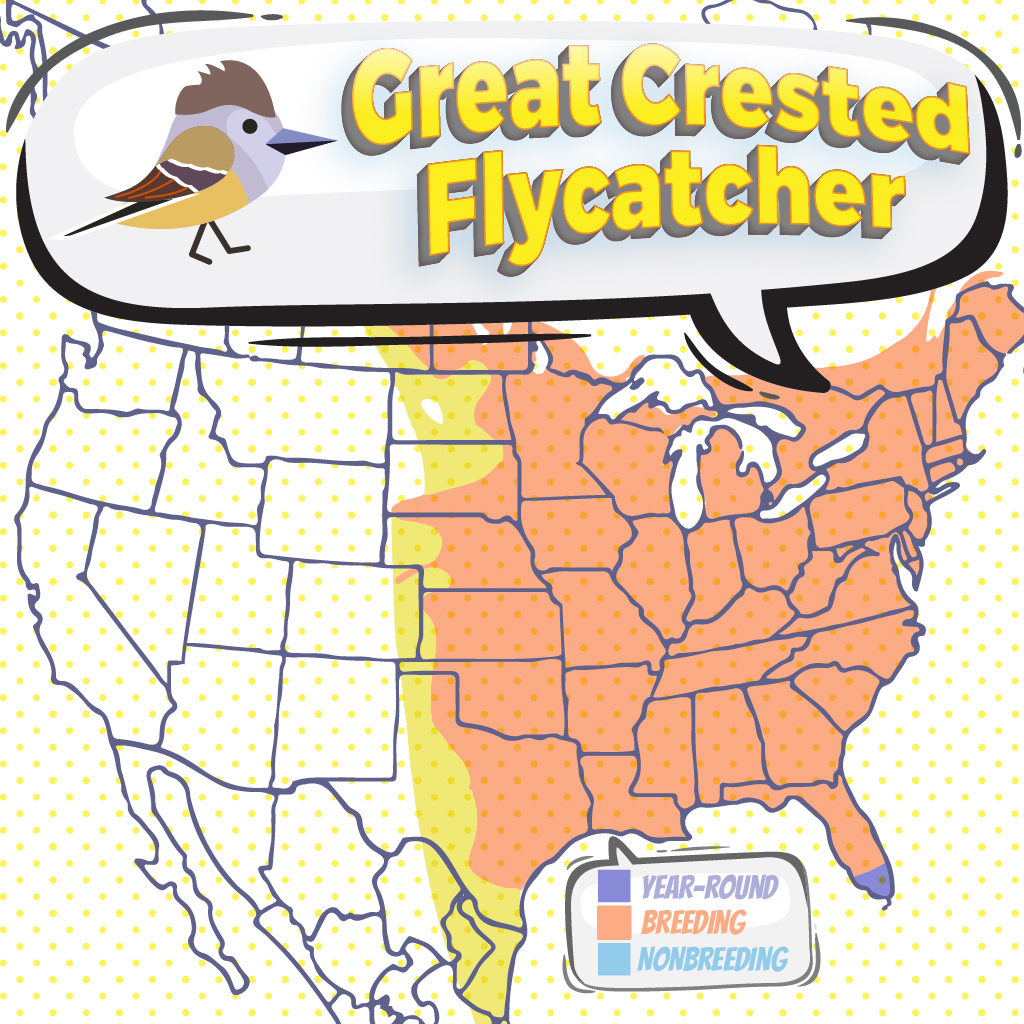
The summer breeding range of these birds begins from Manitoba, the extreme southern portions of the St. Lawrence forest of Ontario, Quebec, northeast Nova Scotia, and parts of Prince Edward Island in Canada. The breeding range also covers all of the eastern, mid-eastern, and parts of the central United States. This includes Northern and Southern parts of Florida, parts of Texas, central Oklahoma, and eastern and central North Dakota. Migration seasons take them towards most of southern Mexico and the Yucatan Peninsula, sometimes extending to the coasts of Central America as well. Small populations that live in southern peninsular Florida are also permanent residents that do not migrate.
Great Crested Flycatcher Lifecycle
After the breeding practices of a pair, the female lays 4–8 creamy white to buff eggs. Only the female incubates the eggs, with the incubation period lasting 13-15 days. After the chicks hatch, they are in a helpless state without down feathers or sight. However, by another 13-15 days they are ready to leave their nests.
Nesting
These birds can be found nesting in cavities. They tend to prefer natural cavities in dead trees but will use abandoned woodpecker holes, nesting boxes, hollow posts, and even buckets, pipes, cans, and boxes of the required size if available. Both members of the pair scout for potential nesting cavities anywhere between 2 and 70 feet above the ground, but the females likely make the final selection.
The nest-building is entirely done by the female while the male supervises and keeps her company. If the cavity is deeper than 12 inches, she first fills it with debris before building her nest in the remaining space. A variety of materials are used in weaving in the nest. These include grasses, leaves, twigs, stems, fur and hair, snail shells, seashells, feathers, bark, moss, cellophane, onion skin, paper, cloth, eggshells, and snakeskin. These birds are known for their preference for snakeskin, with a majority of Great Crested Flycatcher nests utilizing brittle items like snakeskins and onions.
The resultant nest has an inner cup that is around 3-3.5 inches across, and 1.5-2 inches deep. Females may continue to add finer materials like feathers to the nest during egg-laying, incubation, and brooding.
Anatomy of a Great Crested Flycatcher
These birds are relatively large Woodpeckers with long and lean body proportions, sporting a powerful build with broad shoulders and a large head. Their crest is not especially prominent, but it is lemon-yellow and stands out if one catches sight of these birds. Their bills are relatively long at the base and are straight, with their tails being fairly long. They are generally larger than Eastern Bluebirds but are smaller than American Robins.
Final Thoughts
According to recent surveys, there have been local increases in their populations due to the fragmentation of woodlands as a result of logging. Decreases in their populations are generally due to competition for nesting with other bird species and squirrels. However, they have benefitted from the gradual shift in their surrounding habitats. However, clean forestry practices have reduced the number of suitable natural cavities by removing dead snags and other dead parts of trees from the forests.
These birds frequently visit urban areas as they are fairly tolerant of humans. If you live around their breeding range, you can try putting up a nest box to attract a breeding pair. If you put it up well in advance before the breeding season, your chances of spotting it rise considerably. Make it such that it provides sufficient safety from predators who eat the eggs and the young, preferably at a height of 12-20 feet above the ground. If they happen to come across your nest-box and deem it to be a suitable location, you might get to have these yellow-crested birds for company during your summers!
Ornithology
Bird Watching Academy & Camp Subscription Boxes
At the Bird Watching Academy & Camp we help kids, youth, and adults get excited and involved in bird watching. We have several monthly subscription boxes that you can subscribe to. Our monthly subscription boxes help kids, youth, and adults learn about birds, bird watching, and bird conservation.
- Kids Bird Watching Monthly Subscription$10.00 / month
- Kid & Adult Bird Watching Starter Pack Subscription$10.00 / month and a $72.00 sign-up fee
- Kids Bird Watching Starter Pack Subscription$10.00 / month and a $19.00 sign-up fee
Bird Watching Binoculars for Identifying Great Crested Flycatchers
The most common types of bird watching binoculars for viewing Great Crested Flycatchers are 8×21 binoculars and 10×42 binoculars. Bird Watching Academy & Camp sells really nice 8×21 binoculars and 10×42 binoculars. You can view and purchase them here.
- Birding Binoculars$49.99
- Kids Binoculars$13.99
Great Crested Flycatcher Iron On Patches
Kids, Youth, and Adults love to collect our Bird Watching Academy & Camp iron on patches. Our bird watching patches help you keep track of the birds you have seen an identified. You can also display the patches on our Bird Watching Academy & Camp banners.
The Great Crested Flycatcher is a great iron on patch to start your collection with. The patches are durable and can be sewn on or ironed on to just about anything.
- Great Crested Flycatcher Iron on Patch$2.99
- Bird Banner$10.99
Great Crested Flycatcher Stickers
Stickers are a great way for you to display your love for bird watching and the Great Crested Flycatcher. We sell a monthly subscription sticker pack. The sticker packs have 12 bird stickers. These sticker packs will help your kids learn new birds every month.
Bird Feeders ForGreat Crested Flycatchers
There are many types of bird feeders. Bird feeders are a great addition to your backyard. Bird feeders will increase the chances of attracting birds drastically. Both kids and adults will have a great time watching birds eat at these bird feeders. There are a wide variety of bird feeders on the market and it is important to find the best fit for you and your backyard.
Bird HousesForGreat Crested Flycatchers
There are many types of bird houses. Building a bird house is always fun but can be frustrating. Getting a bird house for kids to watch birds grow is always fun. If you spend a little extra money on bird houses, it will be well worth every penny and they’ll look great.




